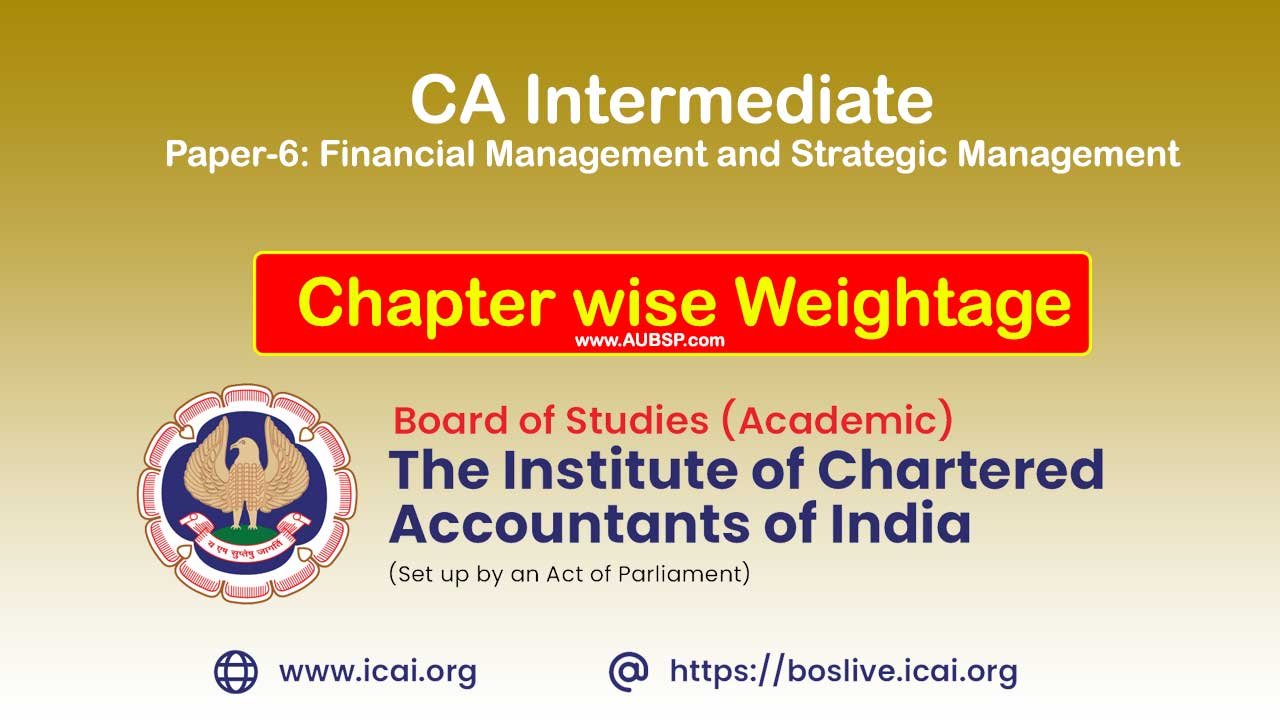CA Intermediate Financial Management and Strategic Management (FM and SM) weightage 2024: The Institute of Chartered Accountants of India (ICAI) has issued updated and revised Section-wise Weightage for CA Intermediate Paper-6 Financial Management and Strategic Management applicable for September 2024 and subsequent exams till further changes are made.
Chapter wise marks distribution for CA Intermediate Sept 2024. Weightage of Marks for CA Intermediate Paper-6 Financial Management and Strategic Management. ICAI published skill-wise and section wise weightage for Financial Management and Strategic Management subject of CA Intermediate course.
The Board of Studies (BoS) of the Institute of Chartered Accountant of India (ICAI) has now assigned weightage of marks to various sections of Paper-6 subject. This facility would help students to plan their studies in a structured manner for the coming ICAI Financial Management and Strategic Management examinations.
Accordingly, each subject has been divided into various topics and topics have been grouped into sections and weightage range has been assigned to these sections. The question paper-6 would take into consideration the weightage range assigned to different sections.
Here is the weightage of marks for CA Intermediate subject Paper 1 i.e. Financial Management and Strategic Management. Following are the detail chapter wise and section wise weightage of marks assigned to FM and SM paper. This analysis will be applicable for CA Intermediate course examination to be held in September 2024 onwards under New Scheme of Education and Training.
CA Intermediate Paper-6 Section wise Weightage
| Section No. | Weightage |
|---|---|
| Section A: Financial Management | 50 Marks |
| Section-I: | 10%-15% |
| Section-II: | 45%-50% |
| Section-III: | 20%-25% |
| Section-IV: | 15%-20% |
| Section B: Strategic Management | 50 Marks |
| Section-I: | 15%-25% |
| Section-II: | 15%-25% |
| Section-III: | 15%-25% |
| Section-IV: | 15%-25% |
| Section-V: | 15%-25% |
CA Intermediate Paper-6 Chapter-wise Weightage
| Chapter Name | Weightage |
|---|---|
| Section A: Financial Management | |
| Chapter 1: Scope and Objectives of Financial Management | 2-5 Marks |
| Chapter 2: Types of Financing | 2-8 Marks |
| Chapter 3: Financial Analysis and Planning – Ratio Analysis | 5-10 Marks |
| Chapter 4: Cost of Capital | 15-20 Marks |
| Chapter 5: Financing Decisions – Capital Structure | 15-20 Marks |
| Chapter 6: Financing Decisions – Leverages | 5-10 Marks |
| Chapter 7: Investment Decisions | 10-12 Marks |
| Chapter 8: Dividend Decision | 5-10 Marks |
| Chapter 9: Management of Working Capital | 8-10 Marks |
| Section B: Strategic Management | |
| Chapter 1: Introduction to Strategic Management | 8-12 Marks |
| Chapter 2: Strategic Analysis: External Environment | 8-12 Marks |
| Chapter 3: Strategic Analysis: Internal Environment | 8-12 Marks |
| Chapter 4: Strategic Choices | 8-12 Marks |
| Chapter 5: Strategy Implementation and Evaluation | 8-12 Marks |
CA Intermediate Weightage of Marks for FM SM
Section A: Financial Management (50 Marks)
Section-I (Weightage 10%-15%) i.e. 5-8 Marks
- Financial Management and Financial Analysis
(i) Introduction to Financial Management Function
a) Objective and scope of financial management.
b) Profit Maximisation, Wealth Maximisation and Value Creation.
c) Role of Financial Manager and Financial Controller.
d) Financial management environment.
e) Functions of finance executives in an organization.
f) Financial distress and insolvency.
(ii) Financial Analysis through Ratios
a) Users of the financial analysis
b) Sources of financial data for analysis
c) Calculation and Interpretation of ratios.
d) Limitations of ratio analysis
Section-II (Weightage 45%-50%) i.e. 22-25 Marks
- Financing Decisions and Cost of Capital
(i) Sources of Finance
a) Different Sources of Finance, Characteristics of different types of long-term debt and equity finance, Method of raising long term finance
b) Different Sources of shortterm Finance
c) Contemporary sources of funding- P2P lending, Equity funding, Crowd funding, Start-up funding, etc.
d) Internal fund as a source of finance
e) International sources of finance
f) Other sources of finance-Lease Financing, Sale and lease back, Convertible debt, Venture capital, Grants etc.
(ii) Cost of Capital
a) Significance of cost of capital
b) Factors of cost of capital
c) Measurement of costs of individual components of capital
d) Weighted average cost of capital (WACC)
e) Marginal cost of capital
(iii) Capital Structure Decisions
a) Significance of capital structure
b) Determinants of capital structure
c) Capital structure planning and designing
d) Designing of optimum capital structure
e) Theories of Capital Structure and value of the firmrelevancy and Irrelevancy of capital structure.
f) EBIT- EPS Analysis, Breakeven- EBIT Analysis.
g) Under/ Over Capitalisation.
(iv) Leverages
a) Types of Leverages- Operating, Financial and Combined
b) Analysis of leverages
Section-III (Weightage 20%-25%) i.e. 10-12 Marks
- Capital Investment and Dividend Decisions
(i) Capital Investment Decisions
a) Objective of capital investment decisions
b) Methods of Investment appraisal:
- Payback period, Discounted payback period
- Accounting Rate of Return (ARR),
- Net Present Value (NPV) – The meaning of NPV, Strengths and limitations of NPV method, The working capital adjustment in an NPV analysis, Capital rationing, Equivalent Annual Costs,
- Internal Rate of return (IRR)- Limitations of the IRR method, Multiple IRRs,
- Modified internal Rate of Return (MIRR)- Definition and explanation of MIRR, Process for calculating MIRR, Strengths of the MIRR approach.
- Profitability Index
(ii) Dividend Decisions
a) Basics of Dividends
b) Cash dividend, stock dividend/ bonus share, stock-splits, share buy back
c) Determinants of dividend
d) Relevancy and Irrelevancy of Dividend Policies- Traditional Approach, Walter’s model, Gordon’s model, Modigliani and Miller (MM) Hypothesis.
Section-IV (Weightage 15%-20%) i.e. 8-10 Marks
- Management of Working Capital
a) The management of working capital- Liquidity and Profitability
b) The Working capital financing decisions- Primary and Secondary Sources of Liquidity
c) The working Capital Cycle (operating Cycle), Effectiveness of Working Capital based on its operating and cash conversion cycles
d) Assessment of working capital requirement
e) Management of Accounts Receivables (Debtors)
f) Factoring and Forfaiting
g) Credit Management
- Credit granting
- Monitoring accounts receivables
- Debt collection
h) Management of Accounts Payables (Creditors)
i) Management of Cash, Treasury management
j) Banking norms of working capital finance
Section B: Strategic Management (50 Marks)
Section-I (Weightage 15%-25%) i.e. 8-12 Marks
- Introduction to Strategic Management
(i) Meaning and Nature of Strategic management
(ii) Importance and Limitations of Strategic Management
(iii) Strategic Intent – Vision, Mission and Goals and Values
(iv) Strategic Levels in Organizations (Network, Corporate, Business and Functional)
Section-II (Weightage 15%-25%) i.e. 8-12 Marks
- Strategic Analysis: External Environment
(i) International and Macro Environment: PESTLE Analysis
(ii) Defining the industry for analysis (Value Chain, PLC)
(iii) Porters Five Forces – Industry environment analysis
(iv) Understanding customers and markets
(v) Competition in the industry
Section-III (Weightage 15%-25%) i.e. 8-12 Marks
- Strategic Analysis: Internal Environment
(i) Understanding key stakeholders (Mendelow’s Model)
(ii) Strategic drivers (Industry & markets, Customers, Channels, Product & Services, Competitive Advantage)
(iii) The role of resources and capabilities
(iv) Combining external and internal analysis (SWOT Analysis)
(v) Gaining competitive advantage (Michael Porter’s Generic Strategies)
Section-IV (Weightage 15%-25%) i.e. 8-12 Marks
- Strategic Choices
(i) Strategic Choices: Concentric, Conglomerate, Market Development, Product Development, Innovation, Horizontal integration, vertical integration, Turnaround, Divesture, Liquidation
(ii) How to Develop Strategic Options- Ansoff’s Matrix
- ADL Matrix
- BCG Matrix
- GE Matrix
Section-V (Weightage 15%-25%) i.e. 8-12 Marks
- Strategy Implementation and Evaluation
(i) Implementation: Formulation vs. Implementation Matrix, Linkages and Issues
(ii) Strategic Change through Digital Transformation
(iii) Organisation Structure (hard) and Culture (soft)
(iv) Strategic Leadership
(v) Strategic Control
(vi) Strategic Performance Measures


